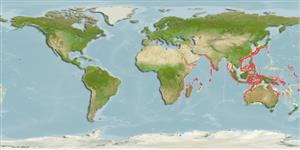>
Acropomatiformes (Oceanic basses) >
Acropomatidae (Lanternbellies, temperate ocean-basses)
Etymology: Acropoma: Greek, akro = topmost, summit + Greek, poma, -atos = cover (Ref. 45335).
More on author: Günther.
Environment: milieu / climate zone / depth range / distribution range
Ökologie
seewasser bathypelagisch; tiefenbereich 35 - 100 m (Ref. 123727). Deep-water; 36°N - 37°S, 21°E - 154°W
Western Pacific: Japan, East China Sea and South China Sea.
Size / Gewicht / Alter
Maturity: Lm ? range ? - ? cm
Max length : 8.1 cm SL Männchen/unbestimmt; (Ref. 123726)
Rückenflossenstacheln (insgesamt) : 9; Rückenflossenweichstrahlen (insgesamt) : 10; Afterflossenstacheln: 3; Afterflossenweichstrahlen: 7. Body moderately elongate, compressed. Scales large, weakly ciliated and deciduous. Two luminous organs run longitudinally in the abdominal muscle from the thorax to slightly beyond the anus and join each other at the anterior extremities.
Inhabits sand and sandy mud bottoms (Ref. 11230). Marketed fresh or reduced to fishmeal.
Life cycle and mating behavior
Geschlechtsreife | Fortpflanzung | Ablaichen | Eier | Fecundity | Larven
Okamoto, M., J.E. Randall, H. Motomura, 2021. Acropoma musortom, a new lanternbelly (Acropomatidae) from the South Pacific and the first record of Acropoma splendens from the Andaman Sea off southwestern Thailand. Ichthyol. Res. 68(4):517-528. (Ref. 123726)
IUCN Rote Liste Status (Ref. 130435: Version 2024-2)
Bedrohung für Menschen
Harmless
Nutzung durch Menschen
Fischereien: kommerziell
Tools
Zusatzinformationen
Download XML
Internet Quellen
Estimates based on models
Preferred temperature (Ref.
123201): 11.8 - 21.3, mean 15.7 °C (based on 290 cells).
Phylogenetic diversity index (Ref.
82804): PD
50 = 0.5156 [Uniqueness, from 0.5 = low to 2.0 = high].
Bayesian length-weight: a=0.01202 (0.00700 - 0.02066), b=2.99 (2.84 - 3.14), in cm total length, based on LWR estimates for this species & (Sub)family-body (Ref.
93245).
Trophic level (Ref.
69278): 3.3 ±0.40 se; based on food items.
Widerstandsfähigkeit (Ref.
120179): mittel, Verdopplung der Population dauert 1,4 - 4,4 Jahre. (Assuming tmax>3).
Fishing Vulnerability (Ref.
59153): Low vulnerability (10 of 100).
